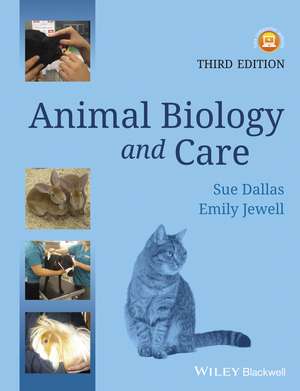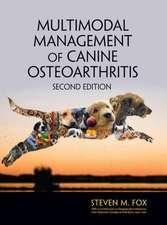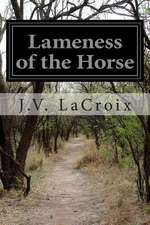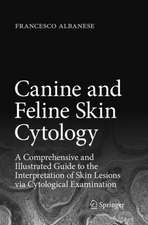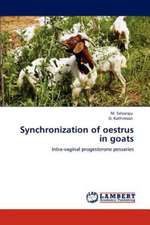Animal Biology and Care 3e
Autor S Dallasen Limba Engleză Paperback – 12 iun 2014
Key features include:
- New content on exotic species, recognising the increasing number of these animals kept as pets.
- Extensive coverage of the Animal Welfare Act 2006 and recent advances in animal welfare.
- Written in line with course curricula, chapter summaries help you to remember key points and learning objectives.
- A companion website has interactive MCQs to help you test your knowledge.
Preț: 260.78 lei
Preț vechi: 274.50 lei
-5% Nou
49.90€ • 52.24$ • 41.29£
Carte disponibilă
Livrare economică 15-29 martie
Livrare express 01-07 martie pentru 43.28 lei
Specificații
ISBN-10: 111827606X
Pagini: 370
Ilustrații: illustrations (black and white, and colour)
Dimensiuni: 190 x 245 x 19 mm
Greutate: 0.8 kg
Ediția:3rd Edition
Editura: Wiley
Locul publicării:Chichester, United Kingdom
Public țintă
Students on animal care, animal nursing assistant and veterinary care assistant courses.Descriere
The perfect study companion, Animal Biology and Care, 3rd Edition is specifically designed for students on animal care, animal nursing assistant and veterinary care assistant courses. This edition is fully updated with new course content, a refreshed design and colour illustrations throughout. Basic biological theory is introduced with diagrams for visual learners while photographs demonstrate the common practical procedures carried out by animal care assistants.
Key features include:
- New content on exotic species, recognising the increasing number of these animals kept as pets.
- Extensive coverage of the Animal Welfare Act 2006 and recent advances in animal welfare.
- Written in line with course curricula, chapter summaries help you to remember key points and learning objectives.
- A companion website at www.wiley.com/go/dallas/animal–biology–care with interactive MCQs to help you test your knowledge.
Divided into three main sections covering animal science and genetics, health and husbandry and nursing procedures, this book will help lay the foundations for a successful career in animal care and management!
Textul de pe ultima copertă
The perfect study companion, Animal Biology and Care, 3rd Edition is specifically designed for students on animal care, animal nursing assistant and veterinary care assistant courses. This edition is fully updated with new course content, a refreshed design and colour illustrations throughout. Basic biological theory is introduced with diagrams for visual learners while photographs demonstrate the common practical procedures carried out by animal care assistants.
Key features include:
- New content on exotic species, recognising the increasing number of these animals kept as pets.
- Extensive coverage of the Animal Welfare Act 2006 and recent advances in animal welfare.
- Written in line with course curricula, chapter summaries help you to remember key points and learning objectives.
- A companion website at www.wiley.com/go/dallas/animal–biology–care with interactive MCQs to help you test your knowledge.
Divided into three main sections covering animal science and genetics, health and husbandry and nursing procedures, this book will help lay the foundations for a successful career in animal care and management!
Cuprins
Preface xi
Acknowledgments xii
Companion Website xiii
Section 1 Animal Biology 1
Chapter 1 Cells and Basic Tissues 3
Summary 3
What is Biology? 3
Cells 6
Animal Tissues 6
Blood 9
Bone and cartilage 13
Muscular tissue 14
Nervous tissue 16
Chapter 2 Movement of Materials within the Body 17
Summary 17
Diffusion 17
Osmosis 18
Phagocytosis 19
Active transport 19
Body fluid 19
Acids and bases in the body 20
Tissue fluid and the lymphatic system 20
The lymphatic system 21
Functions of the lymphatic system 22
Chapter 3 Body Systems and Functions 24
Summary 24
The circulatory system 24
The respiratory system 31
The digestive system 40
The urinary system 51
The nervous system 53
The endocrine system 59
The sense organs 62
The skin 66
The skeleton 68
The reproductive system 73
Homeostasis 79
Chapter 4 Basic Genetics 81
Summary 81
What is genetics? 81
Why is genetics important? 81
Important events in the history of genetics 81
Chromosomes, genes and DNA 82
Genetic terms 83
Cell division 83
Breeding and genetics 87
Chapter 5 Body Areas 89
Summary 89
Thoracic cavity 89
Abdominal cavity 89
Pelvic region 90
Cavity linings 90
Section 2 Animal Health and Husbandry 91
Chapter 6 Animal Welfare 93
Summary 93
Definition of animal welfare 93
How is animal welfare assessed? 94
Animal welfare legislation 95
Animal welfare organisations 106
Animal rights 107
Chapter 7 Basic Animal Health Care 108
Summary 108
Assessing the health status of an animal 108
Factors affecting health status 112
Prophylactic treatments 116
Microchipping 116
Chapter 8 Disease Transmission and Control 118
Summary 118
How can disease be transmitted? 118
Incubation of disease 122
Infection 122
Diagnosis of disease 123
Basic animal treatments 124
Chapter 9 Basic Microbiology 127
Summary 127
Microbial terms 128
Bacteria 128
Viruses 132
Fungi 132
Protozoa 133
Chapter 10 Diseases of the Dog and Cat 135
Summary 135
Diseases of dogs 135
Diseases of cats 141
Immunity 148
Chapter 11 Zoonotic Diseases 149
Summary 149
Dogs 149
Cats 150
Zoonotic diseases from other species 150
Prevention of zoonotic diseases 150
Chapter 12 Parasitology 152
Summary 152
Parasitology terms 153
External parasites 153
Ectoparasites in birds 160
Ectoparasites in reptiles 160
Internal parasites 161
Chapter 13 Hygiene 166
Summary 166
Disinfectants and antiseptics 166
Terms relating to hygiene 167
Disinfectants 167
Antiseptics 172
Chapter 14 Basic Nutrition 174
Summary 174
Proteins 175
Carbohydrates 177
Fats/lipids 178
Vitamins 178
Minerals 179
Water 181
General considerations for feeding 182
Life stages for nutrition of the dog and cat 182
Nutritional differences between the dog and the cat 183
Home–made diets 184
Feeding guidelines 184
Nutritional balance 185
Dietary supplementation 185
Growing puppies and kittens 186
Adult 187
Working dogs 187
Senior dogs and cats 187
Pregnancy 189
How much should be fed? 190
Chapter 15 Handling 191
Summary 191
Possible reasons for handling 191
Approaching an animal for handling 192
Handling procedures 192
Restraint procedures in the dog and cat 198
Chapter 16 Grooming and Coat Care 202
Summary 202
Reasons for grooming 202
Main aims of grooming 203
Grooming dogs 203
Cats 220
Chapter 17 Other Animals Kept as Pets 225
Summary 225
Basic husbandry for other animals 225
Small mammals 227
Birds 252
Fish 259
Reptiles, amphibians and invertebrates 267
Section 3 Nursing 271
Chapter 18 First Aid and Nursing 273
Summary 273
First aid 273
Evaluating situations requiring first aid intervention 274
Poisons 282
Insect stings 283
Bleeding or haemorrhage 283
Shock 285
Heat stroke (hyperthermia) 287
Hypothermia 288
Bone fractures 289
Wounds 290
Types of wound 291
Eye injuries 292
Chapter 19 Basic Bandaging 294
Summary 294
Reasons for bandaging 294
Aims of bandaging 295
Rules for bandaging 296
Application 296
Chapter 20 The Hospital Environment 299
Summary 299
Environmental temperature in the hospital environment 300
Hygiene and cleaning 301
Routine room cleaning 302
Chapter 21 The Hospitalised Patient 308
Summary 308
Records and monitoring 308
Observation 308
Feeding and watering 309
Hygiene 310
Temperature control 311
Recumbent patients 312
Handling the hospitalised patient 312
Welfare during hospitalisation 313
Nursing models 313
Isolation and barrier nursing 314
Pathogenic resistance 314
Medication 315
Fluid therapy 315
Environmental enrichment 315
Chapter 22 Monitoring Temperature, Pulse and Respiration 317
Summary 317
Temperature 317
Pulse 320
Respiration 322
Chapter 23 Pharmacy and the Administration of Drugs 325
Summary 325
Routes of administration 326
Pharmacology and dispensing 327
Handling and dispensing of drugs 330
Drugs glossary 332
Chapter 24 Isolation and Quarantine 333
Summary 333
Isolation 333
Quarantine 334
Further Reading 337
Appendix: Anatomy and Physiology Terminology 341
Index 345
Recenzii
The depth, detail, and subject matter of this book are definitely appropriate for veterinary assistant students, and the price is in line with most soft–covered textbooks of similar size and quality. (JAVMA, 15 December 2014)
Notă biografică
Sue Dallas VN Cert. Ed. is a qualified veterinary nurse, and has worked in veterinary schools and veterinary practices in the UK and in North America. She has taught on both veterinary nursing and animal care courses for over 22 years and has been involved in a number of educational and examination developments in the UK and New Zealand. Sue has spoken at veterinary congresses both in the UK and around the world, promoting nursing and care of animals through training and education.
Emily Jewell BSc (Hons), MSc, Cert. Ed. is a Curriculum Area Manager in Animal Management at Reaseheath College in Nantwich, Cheshire. Emily graduated from the University of Leeds in 1995 with a BSc (Hons) in Animal Science. After working in a land–based college in Wiltshire for 7 years, she returned to study and graduated from Harper Adams University College in 2003 with an MSc in Animal Health and Welfare. Emily has taught across a range of subjects and has had responsibility for many different species. Emily has also previously worked as an External Verifier in Animal Management for the awarding body Edexcel.
